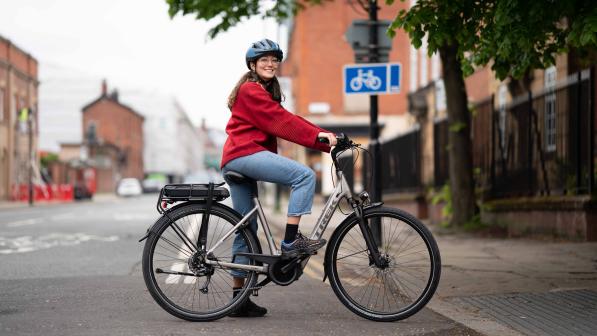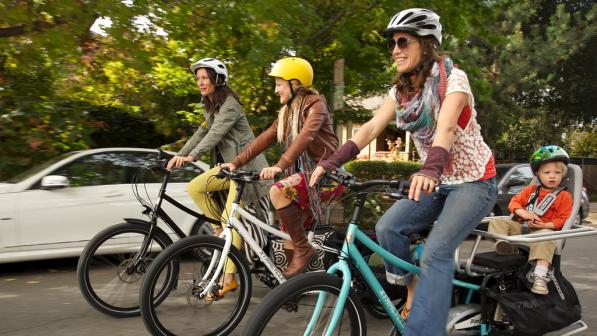Does the government really know how to make e-bikes more popular?

Proposed changes
E-cycle use in the UK has so far been disappointingly low – lagging behind many other countries. Why don’t more people use e-cycles in the UK? The government seems to think it’s because of pesky EU regulations. So, with the very positive ambition of making e-cycles more accessible and attractive – something that Cycling UK wholeheartedly supports – the government has unveiled a plan to change how e-cycles are regulated.
In essence, the changes would double the maximum power of e-bike motors from 250 watts to 500 watts and allow ‘twist and go’ e-bikes, in which the user can use a throttle to reach the existing maximum e-assist speed of 15.5mph without doing any pedalling. Currently, e-bikes are allowed to have throttles that can be used to reach 3.7mph, which are helpful in situations like starting on an incline.
Our concerns
Cycling UK, together with many of our partners in the active travel world, are concerned that the changes would have negative impacts while also doing little to make e-bikes more popular.
Significantly higher power will mean heavier bikes that can carry heavier cargo sharing space with other cyclists and in many cases, due to mixed-use paths, with pedestrians. They will also be able to accelerate more quickly and will be easier to tamper with to significantly increase maximum speed – which is already an issue.
All these factors will increase the risk to the rider, fellow cyclists, and to pedestrians, particularly those with disabilities. There is also a risk that the changes would worsen the public’s perception of cyclists and increase calls for cyclists to be licensed and registered, which would almost certainly lead to a fall in cycling levels.
Removing the requirement to pedal would blur the distinction between cycles and motor vehicles. As one witty writer put it: “Call me a pedant, but pedalling seems to be the main defining act of cycling.” One of the economic justifications for investing in much-needed cycle infrastructure is that higher cycling rates lead to public health savings. Removing the need to pedal negates that inherent public health benefit.
Furthermore, the government has long promised to introduce a new category of vehicles which would encompass e-scooters and other low-speed, zero emissions vehicles. It doesn’t make any sense to rashly amend e-cycle regulations instead of creating the new category, which would include vehicles very similar to a high powered, non-pedalled e-bike.
However, thorough research, consultation and scrutiny is required to make sure that the new vehicle category is introduced in a safe and effective way.
Cargo bikes
In its analysis, the government has suggested the possibility of restricting the proposed changes to e-cargo bikes. Our view is that higher power may indeed be useful in cargo bikes, but it would also make them more dangerous to other cyclists and pedestrians.
If cargo bike power is increased, there needs to be a clear regulatory distinction between e-cycles which are limited at 250 watts and those which have higher power. Those that fall into the latter category should have some kind of light-touch licensing or training requirement to ensure that riders know how to safely load cargo, ensure that their brakes are safe, and interact safely with other cyclists and pedestrians.
Currently, there is no clear definition of a cargo bike, so without setting this it would be difficult to apply a set of changes only to cargo bikes.
Alternative measures
Cycling UK is a big believer in the power of e-bikes. They open up the many benefits of cycling to more people, and can help people cycle longer distances or carry more weight. However, we don’t think the proposed changes would actually increase e-bike use.
In a recent poll, we asked our members and supporters which one change would encourage them to either try an e-bike for the first time or to use one more often. Out of 878 respondents, 41% chose “more protected cycle lanes”, 29% chose “grant toward buying an e-bike”, 14% chose “free e-bike loan”, 8% chose “higher maximum speed”, 5% chose “higher power limit”, and 3% chose “not having to pedal (a twist and go e-bike)”.
This tallies with our experience in encouraging people to try e-bikes through our Making cycling e-asier programme, and also explains why some other countries have had higher e-cycle use. Germany, which has the largest e-bike market in Europe with more than 5 million e-bikes sold in 2020, offers both national and regional subsidy schemes to address the cost barrier. In France, e-bike sales have more than tripled since 2016, when an e-bike financial assistance programme was introduced.
Finally, all of the interventions proven to increase cycling rates will also increase e-cycle use. Polling shows that the largest barrier to cycling is perceived danger. Measures such as building and maintaining direct, protected cycle lanes; improving crossings; and lowering speed limits are all tried and tested ways to increase cycling safety. In the Netherlands, which is famous for its high-quality cycle infrastructure, e-cycles now make up the majority of all cycle sales.
Have your say
We recognise that our members and supporter have a range of opinions on the government’s proposal. We encourage you to make your voice heard by responding to the consultation, which closes at 11:59pm on 25 April. You can read our response below and use it in your own submission.


